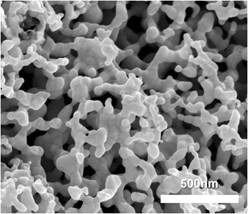Crossref Citations
This article has been cited by the following publications. This list is generated based on data provided by
Crossref.
Burpo, Fred J.
Mitropoulos, Alexander N.
Nagelli, Enoch A.
Ryu, Madeline Y.
and
Palmer, Jesse L.
2018.
Gelatin biotemplated platinum aerogels.
MRS Advances,
Vol. 3,
Issue. 47-48,
p.
2875.
Burpo, Fred J.
Nagelli, Enoch A.
Morris, Lauren A.
Woronowicz, Kamil
and
Mitropoulos, Alexander N.
2018.
Salt-Mediated Au-Cu Nanofoam and Au-Cu-Pd Porous Macrobeam Synthesis.
Molecules,
Vol. 23,
Issue. 7,
p.
1701.
Burpo, Fred J.
Mitropoulos, Alexander N.
Nagelli, Enoch A.
Palmer, Jesse L.
Morris, Lauren A.
Ryu, Madeline Y.
and
Wickiser, J. Kenneth
2018.
Cellulose Nanofiber Biotemplated Palladium Composite Aerogels.
Molecules,
Vol. 23,
Issue. 6,
p.
1405.
Burpo, Fred. J.
Nagelli, Enoch A.
Winter, Stephen J.
McClure, Joshua P.
Bartolucci, Stephen F.
Burns, Alvin R.
O'Brien, Sean F.
and
Chu, Deryn D.
2018.
Salt‐Templated Hierarchically Porous Platinum Macrotube Synthesis.
ChemistrySelect,
Vol. 3,
Issue. 16,
p.
4542.
Burpo, Fred. J.
Nagelli, Enoch A.
Mitropoulos, Alexander N.
Bartolucci, Stephen F.
McClure, Joshua P.
Baker, David R.
Losch, Anchor R.
and
Chu, Deryn D.
2019.
Salt-templated platinum–palladium porous macrobeam synthesis.
MRS Communications,
Vol. 9,
Issue. 1,
p.
280.
Du, Ran
Fan, Xuelin
Jin, Xinyi
Hübner, René
Hu, Yue
and
Eychmüller, Alexander
2019.
Emerging Noble Metal Aerogels: State of the Art and a Look Forward.
Matter,
Vol. 1,
Issue. 1,
p.
39.
Fan, Xuelin
Cai, Bin
Du, Ran
Hübner, René
Georgi, Maximilian
Jiang, Guocan
Li, Lianwei
Samadi Khoshkhoo, Mahdi
Sun, Hanjun
and
Eychmüller, Alexander
2019.
Ligand-Exchange-Mediated Fabrication of Gold Aerogels Containing Different Au(I) Content with Peroxidase-like Behavior.
Chemistry of Materials,
Vol. 31,
Issue. 24,
p.
10094.
Burpo, F. John
Nagelli, Enoch A.
Losch, Anchor R.
Bui, Jack K.
Forcherio, Gregory T.
Baker, David R.
McClure, Joshua P.
Bartolucci, Stephen F.
and
Chu, Deryn D.
2019.
Salt-Templated Platinum-Copper Porous Macrobeams for Ethanol Oxidation.
Catalysts,
Vol. 9,
Issue. 8,
p.
662.
Zhang, Lin
Liu, Xiaosong
Deb, Aarya
and
Feng, Gang
2019.
Ice-Templating Synthesis of Hierarchical and Anisotropic Silver-Nanowire-Fabric Aerogel and Its Application for Enhancing Thermal Energy Storage Composites.
ACS Sustainable Chemistry & Engineering,
Vol. 7,
Issue. 24,
p.
19910.
Georgi, Maximilian
Klemmed, Benjamin
Benad, Albrecht
and
Eychmüller, Alexander
2019.
A versatile ethanolic approach to metal aerogels (Pt, Pd, Au, Ag, Cu and Co).
Materials Chemistry Frontiers,
Vol. 3,
Issue. 8,
p.
1586.
Iqbal, Muhammad
Kaneti, Yusuf Valentino
Kim, Jeonghun
Yuliarto, Brian
Kang, Yong‐Mook
Bando, Yoshio
Sugahara, Yoshiyuki
and
Yamauchi, Yusuke
2019.
Chemical Design of Palladium‐Based Nanoarchitectures for Catalytic Applications.
Small,
Vol. 15,
Issue. 6,
Francis, Nicholas J.
and
Knospe, Carl R.
2019.
Fabrication and Characterization of Nanoporous Gold Electrodes for Sensor Applications.
Advanced Engineering Materials,
Vol. 21,
Issue. 3,
Mitropoulos, Alexander N.
Burpo, F. John
Nguyen, Chi K.
Nagelli, Enoch A.
Ryu, Madeline Y.
Wang, Jenny
Sims, R. Kenneth
Woronowicz, Kamil
and
Wickiser, J. Kenneth
2019.
Noble Metal Composite Porous Silk Fibroin Aerogel Fibers.
Materials,
Vol. 12,
Issue. 6,
p.
894.
Zheng, Yan
Li, Na
Mukherjee, Somnath
Yang, Yingchao
Yan, Junlin
Liu, Jing
and
Fang, Yu
2019.
A Versatile Strategy for Tailoring Noble Metal Supramolecular Gels/Aerogels and Their Application in Hydrogen Evolution.
ACS Applied Nano Materials,
Vol. 2,
Issue. 5,
p.
3012.
Zhang, Ran
and
Zhao, Yan
2020.
Preparation and Electrocatalysis Application of Pure Metallic Aerogel: A Review.
Catalysts,
Vol. 10,
Issue. 12,
p.
1376.
Du, Ran
Joswig, Jan-Ole
Fan, Xuelin
Hübner, René
Spittel, Daniel
Hu, Yue
and
Eychmüller, Alexander
2020.
Disturbance-Promoted Unconventional and Rapid Fabrication of Self-Healable Noble Metal Gels for (Photo-)Electrocatalysis.
Matter,
Vol. 2,
Issue. 4,
p.
908.
Du, Ran
Wang, Jinying
Wang, Ying
Hübner, René
Fan, Xuelin
Senkovska, Irena
Hu, Yue
Kaskel, Stefan
and
Eychmüller, Alexander
2020.
Unveiling reductant chemistry in fabricating noble metal aerogels for superior oxygen evolution and ethanol oxidation.
Nature Communications,
Vol. 11,
Issue. 1,
Wang, Hengjia
Fang, Qie
Gu, Wenling
Du, Dan
Lin, Yuehe
and
Zhu, Chengzhou
2020.
Noble Metal Aerogels.
ACS Applied Materials & Interfaces,
Vol. 12,
Issue. 47,
p.
52234.
Du, Ran
Joswig, Jan‐Ole
Hübner, René
Zhou, Lin
Wei, Wei
Hu, Yue
and
Eychmüller, Alexander
2020.
Freeze–Thaw‐Promoted Fabrication of Clean and Hierarchically Structured Noble‐Metal Aerogels for Electrocatalysis and Photoelectrocatalysis.
Angewandte Chemie,
Vol. 132,
Issue. 21,
p.
8370.
Du, Ran
Jin, Xinyi
Hübner, René
Fan, Xuelin
Hu, Yue
and
Eychmüller, Alexander
2020.
Engineering Self‐Supported Noble Metal Foams Toward Electrocatalysis and Beyond.
Advanced Energy Materials,
Vol. 10,
Issue. 11,




